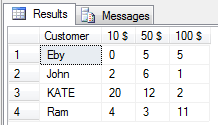What is PIVOT and UNPIVOT operator in SQL Server
We can use the PIVOT and UNPIVOT relational operators to change a table-valued expression into another table. PIVOT rotates a table-valued expression by turning the unique values from one column in the expression into multiple columns in the output, and performs aggregations where they are required on any remaining column values that are wanted in the final output.
Before PIVOT

Before PIVOT table
After PIVOT

After PIVOT table
A simple PIVOT sample in SQL Server
Here we are going to demonstrate a very simple PIVOT sample without any complexity. We are having a table named Accounts and it containing customer name and their deposit with denominations.
Table Structure For showing simple PIVOT sample
CREATE TABLE Accounts(Customer VARCHAR(25), Denomination VARCHAR(20), QTY INT)
GO
-- Inserting Data into Table
INSERT INTO Accounts(Customer, Denomination, QTY)
VALUES('John','10 $',2)
INSERT INTO Accounts(Customer, Denomination, QTY)
VALUES('John','50 $',6)
INSERT INTO Accounts(Customer, Denomination, QTY)
VALUES('John','100 $',1)
INSERT INTO Accounts(Customer, Denomination, QTY)
VALUES('Ram','10 $',4)
INSERT INTO Accounts(Customer, Denomination, QTY)
VALUES('Ram','50 $',3)
INSERT INTO Accounts(Customer, Denomination, QTY)
VALUES('Ram','100 $',11)
INSERT INTO Accounts(Customer, Denomination, QTY)
VALUES('KATE','10 $',20)
INSERT INTO Accounts(Customer, Denomination, QTY)
VALUES('KATE','50 $',12)
INSERT INTO Accounts(Customer, Denomination, QTY)
VALUES('KATE','100 $',2)
INSERT INTO Accounts(Customer, Denomination, QTY)
VALUES('Eby','10 $',0)
INSERT INTO Accounts(Customer, Denomination, QTY)
VALUES('Eby','50 $',5)
INSERT INTO Accounts(Customer, Denomination, QTY)
VALUES('Eby','100 $',5)
In order to PIVOT above mentioned table we can use below script. The result should be as Customer name with all denomination will be coming as columns with qty as values for each column.
SELECT * FROM Accounts PIVOT (SUM(QTY) For Denomination IN ([10 $],[50 $],[100 $])) AS Total
Dynamic Query to PIVOT table for dynamic columns
In the above example we are using a simple structured table and then PIVOT with denomination values. This can be achieved only when we are having denomination values as static. Suppose this denomination values are dynamic (Each country having different denomination like $,EUR, IND etc..), we need to create a dynamic query to PIVOT above table.
Suppose we are having different table for getting Denomination values and we are going to take Denomination values from this table at run time as dynamic.
CREATE TABLE Denomination(Value VARCHAR(25))
GO
INSERT INTO Denomination(Value)
VALUES('10 $')
INSERT INTO Denomination(Value)
VALUES('50 $')
INSERT INTO Denomination(Value)
VALUES('100 $')
First of all, we need to get dynamic columns names from the above table. After that we can create a dynamic query with these columns.
Declare @ColumnNames VARCHAR(100);
SELECT @ColumnNames = COALESCE(@ColumnNames+ ',','') +
'['+ Cast(Value AS VARCHAR(50)) +']' FROM Denomination cust
PRINT @ColumnNames
DECLARE @DynamicQuery Varchar(MAX);
SET @DynamicQuery = '
SELECT * FROM Accounts
PIVOT (SUM(QTY) For Denomination IN (' + @ColumnNames + ')) AS Total'
EXEC (@DynamicQuery);
No comments:
Post a Comment